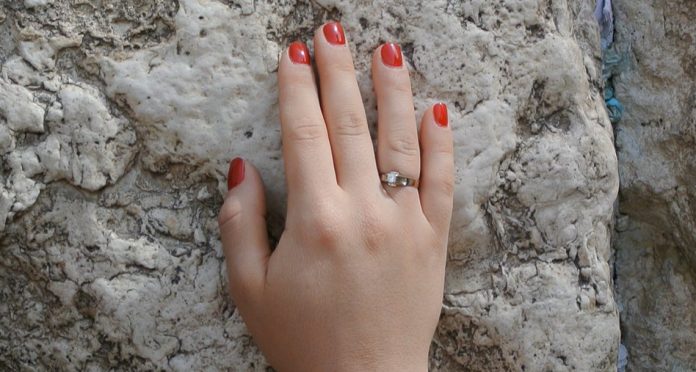(THIS ARTICLE IS MACHINE TRANSLATED by Google from Norwegian)
Moran Ifergan's hour-long documentary Hakir (The Wall) is about a wall unlike any other; the 20 meter high wall which is the last remnant of the Holy Temple of the Jews in Jerusalem, destroyed by the Romans this year 70 AD Like a hundred-year-old pilgrimage site, it has attracted millions upon millions of Jewish visitors – including celebrities such as Bob Dylan, who came here in connection with the son's bar mitzvah ceremony. The wall is also an international tourist attraction with over five million visitors each year – in addition to the political leaders who like to use it as a backdrop for photographs.
None of this information is mentioned in Ifergan's creative documentary. Archeology and celebrities are not what The Wall is about – the film is rather trying to explore how different people can have completely different experiences of the same physical place.
The art of composition. Ifergan uses an unconventional technique to explore deep interpersonal issues: The audio page consists almost entirely of her personal phone calls with her mother and friends – conversations about her ongoing adultery and other family matters. These sound recordings are juxtaposed with pictures of the activities that take place daily at the Wailing Wall. It may be men and women who pray passionately in the sex-segregated sections, or tourists who take selfies; religious who attend the celebration of holidays, and people who place handwritten sheets of paper inside the cavity with requests and wishes for the Almighty – a custom popular even among non-believers.
We never see Ifergan talking on the phone or filming on location, but the film's clipping makes one believe that the phone calls are actually taking place while she is present at the Wailing Wall. We thus follow the intimate and mundane details of the life of a secular 33-year-old filmmaker, while following the public activities in the public square around a national religious monument. It is in these meetings between sound and image that we find the very tension in the film. An example of this is when we hear a moving conversation between Ifergan and her dying grandmother, while we see images of pious women in deep prayer – with outstretched hands grasping the limestone blocks that make up the Wailing Wall.
The filmmaker uses unconventional techniques to explore deep interpersonal issues.
In other scenes, the juxtaposition of sound and image seems rather contradictory, as if Ifergan sets one strong emotion against another. The dialogue in which the filmmaker tells his shocked and sobbing mother that she is to be separated from her husband is juxtaposed with the ceremony where young soldiers swear by the soldier. Here, the individual moves in the opposite direction of the larger community: Ifergan's personal life breaks apart, while the soldiers bond with each other.
In the same way, Ifergan juxtaposes a voice message she receives from an Arab frier – who insists on speaking to her in Arabic ("though I know you may not understand everything I say") – with a scene where young Israeli girls are waving their country's flag during the celebration of Jerusalem Day. Sound and image both show strong emotions, and by contrasting these two expressions of nationalism, viewers are given the opportunity to draw their own conclusions about underlying conflicts.
Ifergan never explains the meaning of any of the compositions. The strength of the film is precisely that it challenges viewers to form their own perception of what they see and feel, without leading narrative voices or action scenes with synchronized sound.
Personal interpretation. With this technique, Ifergan alternates works by certain other filmmakers – especially Israeli Ron Tal, who gets a thanks in the scrolling text. Tal's acclaimed 2007 film, Children of the Sun, seeks to shatter popular beliefs about the collectivist life of Israeli kibbutzim. Here, archive footage and amateur films of seemingly happy kibbutz childhoods are juxtaposed with the anonymous voices of kibbutz veterans, describing painful memories of loneliness and pressure from their surroundings.
Like the kibbutz, the Wailing Wall is also a symbol of Israeli nationalism that has become mythologically idyllic. Partly this is due to the centuries when Jews were denied access to the Wailing Wall; a relationship that culminated in the 19 years of Jordanian rule before the 1967 Six Day War.
But, as Ifergan seems to suggest, not everyone on this landmark feels any sense of pride. Some simply view the wall as a reminder of the unresolved regional conflict. Others, too busy busy arranging their personal lives, may not agree at all.
This is a film that challenges viewers to form their own perception of what they see and feel.
The film's final scene is from a spicy-smelling ceremony that concludes the Jewish Sabbath, in which the participants refresh their senses in preparation for the coming week. Ifergan politely connects this scene to a spoken depiction of how she moves into a new apartment – and embarks on a new journey in life with renewed energy.
There is something refreshing about Ifergan's portrayal of the Wailing Wall, a place that has been endlessly portrayed throughout history. The film gives both a good overview of the robust Jewish connection to the Wailing Wall, and an opportunity for viewers to reflect on the myriad of interpretations that a single place can create for different visitors.






